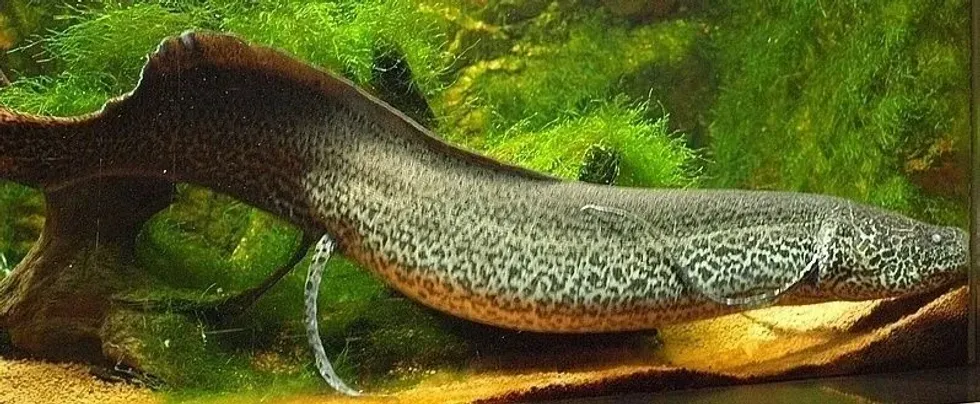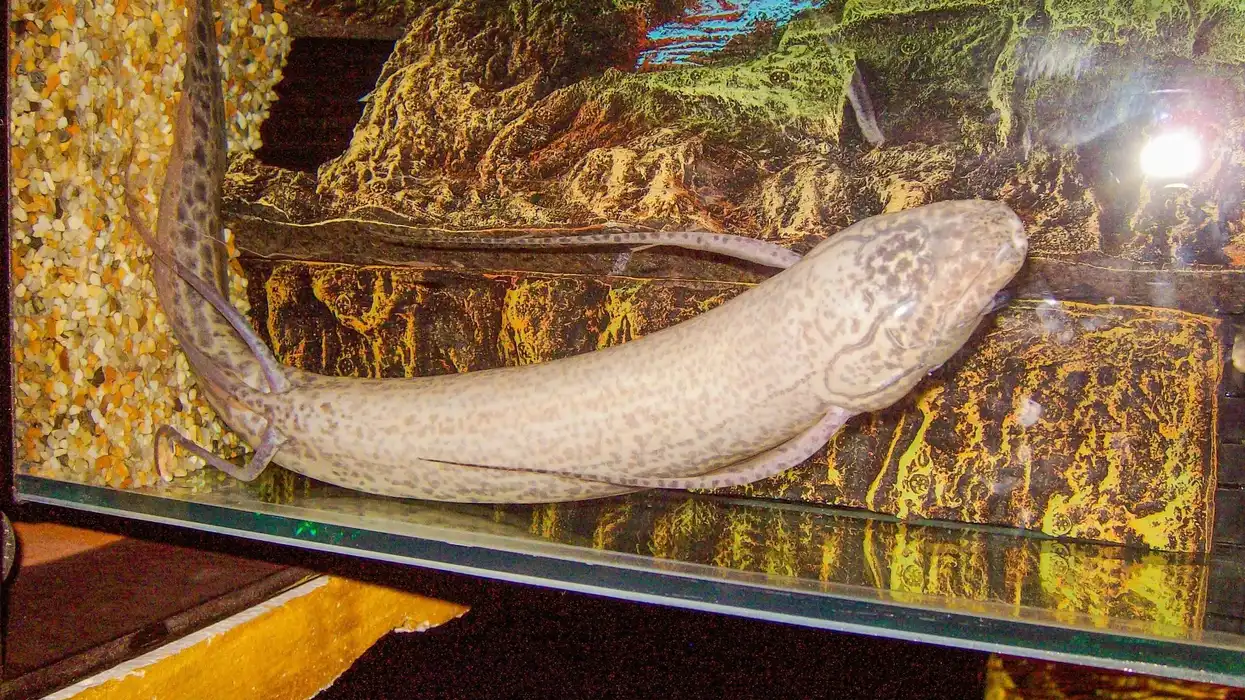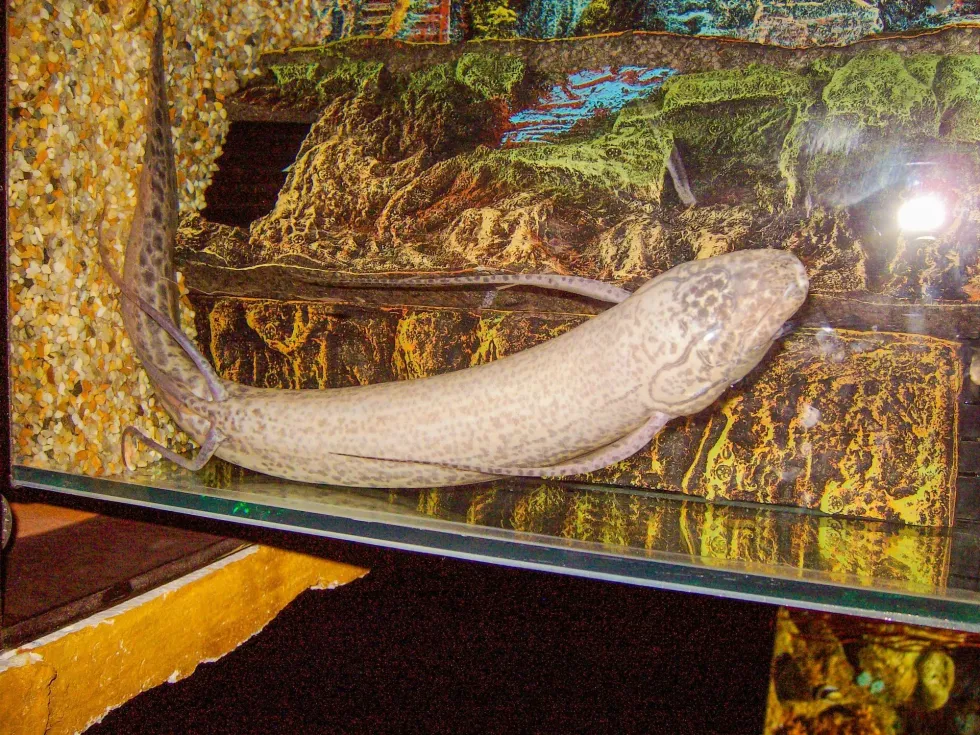Fun Marbled Lungfish Facts For Kids
The marbled lungfish, also called leopard lungfish belongs to the African lungfish (Protopterus annectens) species. It is endemic to Eastern and Central Africa, as well as the Nile region.
During the dry season, it lives only in river reaches and deltas on Lake Tanganyika. Lake Victoria and Lake Baringo support their habitat in pelagic zones and shallow littoral swamps.
The exact number of population estimates is not unknown, but it seems stable. Mollusks like Mutela bourguignati are most commonly consumed by adults. Due to their thin blood vessels and outsized guts, their blood vessels can adapt to such conditions.
The arrangement allows blood flowing through each 'lung' to breathe air. This apparatus allows them to survive where the water evaporates completely during dry seasons.
It can breathe through both its gills and lungs. Their bodies and fins are spotted with dark slate-gray spots that give them the appearance of leopards.
They need to be at the surface to breathe air. Their pectoral and pelvic fins are long and skinny, almost spaghetti-like, and they use them to glide through the water. They have a yellow, gray, or pink coloration for their bodies and fins.
Nests are built in well-vegetated areas by the male after tending to several females. Several females lay eggs in a pit nest.
A female leaves the nest after eight weeks, while a male will stay and guard it for eight weeks, strengthening the eggs' chances of surviving. Marbled lungfishes have been listed as the Least Concern under the IUCN Red List.
If you like reading about marbled lungfishes, you might also like lungfish and the brown trout.
Marbled Lungfish Interesting Facts
What type of animal is a marbled lungfish?
The marbled lungfish, also known as the leopard lungfish, is from Lepidosirenidae. Its scientific name is Protopterus aethiopicus.
What class of animal does a marbled lungfish belong to?
It is a type of lungfish of the genus Protopterus. Lungfish are so named due to their ability to take in oxygen from the atmosphere and the water.
As close as any fish comes to having lungs, their organs are used for this. There are differences between their breathing apparatus and that of anabantoids (livebearers) and other fish species. They can survive where the water evaporates completely during dry seasons using this lung apparatus.
How many marbled lungfish are there in the world?
It has three subspecies, namely, Protopterus aethiopicus aethiopicus., Protopterus aethiopicus congicus, and Protopterus aethiopicus mesmaekersi. The exact number of world population estimate is not unknown, but it seems stable. They are similar to the African lungfishes.
Where does a marbled lungfish live?
The marbled lungfish (Protopterus aethiopicus) is found in the African countries of Angola, Egypt, Ethiopia, Kenya, Republic of the Congo, Rwanda, Sudan, Tanzania, Uganda, and Zambia. Among others, it lives in the Nile and Congo River basins, including nearby lakes.
What is a marbled lungfish's habitat?
Various habitats are inhabited by marbled lungfish (Protopterus aethiopicus).
Most often, it occurs in extreme environments like swampy vegetation areas and floodplains that are subject to severe dehydration and low oxygen conditions. As well as lakes where it occupies a variety of habitats including shallow littoral areas with vegetated vegetation and open water pelagic regions, it is also known to inhabit more stable environments, such as oceans.
Pelagic zones and shallow littoral swamps are its habitats in the Lakes Victoria and Baringo, while at Lake Tanganyika it only occurs in river reaches and deltas.
Who do marbled lungfish live with?
The marbled lungfish (Protopterus aethiopicus) live in small groups or survive alone.
How long does a marbled lungfish live?
The marbled lungfish (Protopterus aethiopicus) has a lifespan of up to 20 years.
How do they reproduce?
Apparently, marbled lungfish (Protopterus aethiopicus) are seasonal breeders who emerge from their cocoons at the start of the rainy season for reproduction. A few weeks after reproduction, they emerge and begin to spawn.
A variety of egg sizes are present in mature female ovaries, and both females in breeding conditions are found throughout the year. An exception is noted in lake Baringo, where marbled lungfish breed throughout the year with no evidence of synchronized breeding with seasons.
During the first maturity in Lake Baringo, males weighed 32.3-34.6 in (82-88 cm) total length (TL), and females weighing 27.6-29.9 in (70-76 cm) TL, and females laid 10,711 eggs per female on average.
A male tends to several females and builds nests in well-vegetated areas. The eggs are laid into the pit nests by one or more females.
Afterward, the females leave the nest, while the male protects it for the next eight weeks, ensuring that the eggs are able to survive without being attacked. Throughout their larval stage, they care for the eggs and young.
What is their conservation status?
This species has been listed as the Least Concern under the IUCN Red List.
Marbled Lungfish Fun Facts
What do marbled lungfish look like?
A marbled lungfish (Protopterus aethiopicus) has a smooth surface, a cylindrical shape, and deeply embedded scales. Tails are long and taper at the end.
They can reach a length of up to 78.7 in (200 cm). Similarly, the pectoral and pelvic fins of this animal are very long and skinny, almost spaghetti-like, used to glide through the water.
A young newly hatched adult has external gills branched like those of newts. A young fish metamorphoses into an adult fish within two to three months, losing its external gills for new gill openings. There are splotches of dark slate-gray over the bodies and fins of these fish, giving them a leopard effect.
The color of their bodies and fins is yellow, gray, or pink. On top, the pattern of colors is darker, and on the bottom, it is lighter.
Researchers found that the marbled lungfish relies most heavily on aquatic respiration, except when restricted by environmental factors or physiological restrictions. It belongs to the same species as African lungfish.

How cute are they?
Protopterus aethiopicus (Marbled lungfish) aren't considered cute as they have a dull-colored appearance resembling mud.
How do they communicate?
Not much information is available about the marbled lungfish (Protopterus aethiopicus) communication behavior but most communicate with each other using sound, with frequency ranges varying.
How big is a marbled lungfish?
The Protopterus aethiopicus (marbled lungfish) is 78.7 in (200 cm), which is 6.6 feet in length.
How fast can a marbled lungfish swim?
Despite its reputation for being slow and inactive, lungfish can move very quickly using the strength of their tail.
How much does a marbled lungfish weigh?
The Protopterus aethiopicus (marbled lungfish) species weighs about 37.5 lb (17 kg).
What are the male and female names of the species?
There is no specific name for separate sexes of marbled lungfish species. They are simply referred to as the female marbled lungfish and the male marbled lungfish.
What would you call a baby marbled lungfish?
The baby marbled lungfish species is called a hatchling, larvae, or fry.
What do they eat?
Mutela bourguignati species is the most common type of mollusk eaten by an adult lungfish. When they are juveniles, they consume almost entirely insects, as well as small fish.
Marbled lungs eat all forms of protein for their diet because they are carnivores. It is important for them to eat meat. Fresh aquatic fish, small chunks of fish, worms, shrimp, and crawfish should be provided, as well as live, fresh dead, or frozen foods are the must include diet.
Providing live, dead, or pieces of fish is the easiest way to supply food. Probably the next easiest diet item will be insects, shrimp, crabs, clams, or any animal that cannot escape the vacuum in their mouth.
Are they dangerous?
This species can be dangerous since they use their strong tails to attack anything they perceive to be a threat.
Would they make a good pet?
Yes, they make a good pet. This fish species is mostly consumed as food, but this depends on the particular community.
Some cultures find it a delicacy, while others think it is taboo to eat it. Traditional medicines are prepared from the parts of this fish in some regions. Providing it with enough room as it grows, these African lungfish (Protopterus annectens) species are actually quite easy to care for.
Depending on the subspecies, they can grow to 3 - 6 ft (0.9-1.8 m) in length. You can feed them right out of your hand, and they need very little water.
By holding the food before them, tongs can ensure the food is consumed quickly and won't have time to pollute the water. As they mature, lungfish will only need to eat two to three times a week.
These fishes are large and messy. To keep the tank/aquarium clear, a large, high-quality filter is needed. In addition to the small amount of space it requires for swimming, this fish needs a large aquarium to allow it to spread out completely.
The majority of home-grown specimens don't require much space and are usually inactive. Keep the tank/aquarium clean by using a strong filter.
It seems that these fishes don't mind how the aquarium is decorated so long as it has a muddy bottom. Lighting should be subdued, and they should have some hiding places.
The ideal tank for them would be 12 in (30 cm), with a muddy bottom, some vegetation, and a muddy bottom. To breathe, this fish species must be able to reach the surface.
In order to prevent this fish from drowning, the aquarist needs to ensure the fish can reach the surface for air. A clear water surface must be ensured.
Unless it is breathing, the leopard lungfish is mostly found floating around on the aquarium's bottom. Its very soft skin may be easily damaged by sharp edges and rough gravel.
Did you know...
The fish is mostly consumed as food, but this depends on the particular community. Some cultures find it a delicacy, while others think it is taboo to eat it. Traditional medicines are prepared from the parts of this fish in some regions.
Lungfishes living in the African subcontinent are called African lungfish and belong to the same species as marbled lungfish.
Marbled Lungfish don't have any predators as such.
How long can a lungfish live out of water?
In its cocoon, it can survive up to a year without water, breathing through its lungs until rains refill its waterway. These fishes are quite similar to the African lungfishes.
There are two-gill arches on the front of these eel-like fish, which house the gills. This tiny respiratory organ, however, is insufficient to provide the only form of oxygen.
Their aquatic habitat can become dried up, or their environments may have a lower concentration of oxygen. Their blood vessels have thin walls, and their guts are out-pocketed to adapt to such situations.
Blood flowing through each 'lung' is able to breathe in oxygen thanks to this arrangement. Their lungs and gills both function as breathing apparatuses.
In order to create a cocoon around their body, these animals secrete mucus, which forms a protective layer around them as their habitat dries up. After that, they can stay in this cocoon for as long as a year or until the next rainfall rejuvenates their habitat.
Are lungfish aggressive?
Despite not really being aggressive, they will eat nearly anything they can get into their mouths. Big mouths and huge appetites characterize them. Thus, they should be kept alone in a tank.
Here at Kidadl, we have carefully created lots of interesting family-friendly animal facts for everyone to discover! For more relatable content, check out these catfish fun facts or parrot fish interesting facts.
You can even occupy yourself at home by coloring in one of our free printable marbled lungfish coloring pages.
We Want Your Photos!
More for You
See All
Bachelor of Arts specializing in Linguistics

Martha MartinsBachelor of Arts specializing in Linguistics
Martha is a full-time creative writer, content strategist, and aspiring screenwriter who communicates complex thoughts and ideas effectively. She has completed her Bachelor's in Linguistics from Nasarawa State University. As an enthusiast of public relations and communication, Martha is well-prepared to substantially impact your organization as your next content writer and strategist. Her dedication to her craft and commitment to delivering high-quality work enables her to create compelling content that resonates with audiences.
Disclaimer
1) Kidadl is independent and to make our service free to you the reader we are supported by advertising. We hope you love our recommendations for products and services! What we suggest is selected independently by the Kidadl team. If you purchase using the Buy Now button we may earn a small commission. This does not influence our choices. Prices are correct and items are available at the time the article was published but we cannot guarantee that on the time of reading. Please note that Kidadl is a participant in the Amazon Services LLC Associates Program, an affiliate advertising program designed to provide a means for sites to earn advertising fees by advertising and linking to Amazon. We also link to other websites, but are not responsible for their content.
2) At Kidadl, we strive to recommend the very best activities and events. We will always aim to give you accurate information at the date of publication - however, information does change, so it’s important you do your own research, double-check and make the decision that is right for your family. We recognise that not all activities and ideas are appropriate for all children and families or in all circumstances. Our recommended activities are based on age but these are a guide. We recommend that these ideas are used as inspiration, that ideas are undertaken with appropriate adult supervision, and that each adult uses their own discretion and knowledge of their children to consider the safety and suitability. Kidadl cannot accept liability for the execution of these ideas, and parental supervision is advised at all times, as safety is paramount. Anyone using the information provided by Kidadl does so at their own risk and we can not accept liability if things go wrong.
3) Because we are an educational resource, we have quotes and facts about a range of historical and modern figures. We do not endorse the actions of or rhetoric of all the people included in these collections, but we think they are important for growing minds to learn about under the guidance of parents or guardians.







